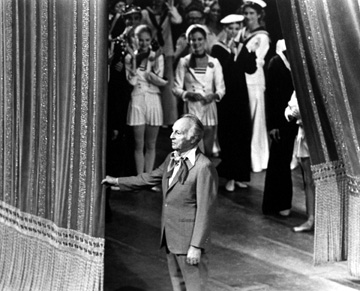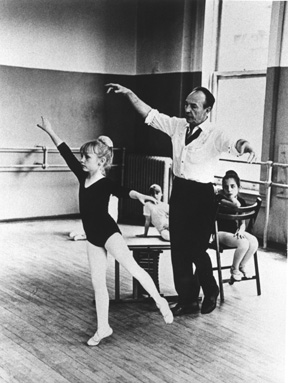Preview:
Must
See TV:
The Balanchine Biography
Balanchine,
Parts I and II
PBS
January 14, 2003
By
Dale Brauner
copyright © 2004 by Dale Brauner

Twenty years ago, PBS paid tribute to a true master of his field, choreographer George Balanchine, with a biography on its Great Performances series. With great research and thought, the makers of the program created a survey of interest and importance. It was called, Balanchine, Parts I & II, which was shown in two separate nights on May 28 and June 4, 1984. On January 14, to commemorate the centennial of Balanchine’s birth, PBS will for the first time rebroadcast the two-hour show on the American Masters series (fitting since Balanchine was proud of his adopted nationality and preferred being called ballet master). A DVD will be released in February.
The program—produced by Judy Kinberg, written by Holly Brubach, directed by Merrill Brockway, edited by Girish Bhargava, with Nancy Reynolds as research director—was conceived to follow the example set by Balanchine’s Midsummer Night’s Dream or Harlequinade—the first part would follow the story line, the second would explore the themes of his work.
“Although we used his 1928 Apollo as a metaphor for Balanchine’s art throughout both programs, each part has its own individual momentum,” Brubach said in a May 1984 New York Times article by John Gruen.
The first hour covers the years from Balanchine’s birth in 1904 to the premiere of the New York City Ballet at Lincoln Center, New York in 1964. The second focuses on Balanchine’s philosophy, his thoughts on music, Stravinsky, teaching, choreography, and dancing in general. You won’t get the inside dirt on Balanchine’s personal life, which has been explored in greater length in the excellent films of Anne Belle and Deborah Dickson, Dancing for Mr. B: Six Balanchine Ballerinas and Suzanne Farrell: Elusive Muse.
Brubach wrote an excellent script, subtly narrated by actor Frank Langella, but when it comes to dance biographies, the most important thing is the visuals. The research is extensive in its use of film and photographs. The filmmakers famously unearthed some rarely seen and priceless footage. Brockway had worked with Balanchine on the 1970s Dance in America series, so that was available. The group used footage from Canadian cultural programs, American variety shows The Bell Telephone Hour and Ed Sullivan, home movies and pirated films. But film from the “Live and Lincoln Center” shows could not be used due to contractual reasons.

With the creation of the program just months after Balanchine died in April 1983, all of the footage shown came during the choreographer’s lifetime—his dancers under his eye and coaching. If it were made now, most likely we would see footage of the current New York City Ballet or national and international companies who perform his works. Also important is the length of the clips, which are long enough to get a feel for the ballets and the performances.
There are home movies of The Card Game and The Bat from the 1930s, several generations of Apollo, glimpses of Vera Zorina in I Married an Angel on Broadway (in addition to clips from her films), Balanchine coaching Mikhail Baryshnikov in Prodigal Son and rehearsing Union Jack, the ballet master showing off Suzanne Farrell to Stravinsky, Diana Adams and Tanaquil LeClercq and early performances of Agon and Western Symphony, respectively.
However, not everything was considered suitable, the filmmakers wanting to stay true to the ballets. For example, the group felt it was very important to have footage of the landmark Serenade—the first ballet Balanchine created in the United States in 1935. There was an exceptional broadcast done on the CBC in 1957 with Diana Adams, Yvonne Mounsey, Patricia Wilde, Herbert Bliss, and Jacques d'Amboise, but it did not give the full scope of the work. Serenade also had filmed in Germany in 1973 with odd camera angles and editing decisions. In the end, the raw footage from Germany was sent for and re-edited.
Film circa
1946 from the Museum of Modern Art of Elegie was not used, but
silent footage of Diana Adams, Tanaquil LeClercq, Andre Eglevsky in Concertino
is, as well as LeClercq in La Valse.

Filmed interviews are used as well, of Balanchine’s wife Tamara Geva and early companion Alexandra Danilova in the first hour, and Balanchine himself throughout, but especially in the second part. Charming are the interviews of Balanchine and Stravinsky together.
“Balanchine’s prolific body of choreographic work revolutionized ballet,” said Susan Lacy, creator and executive producer of American Masters. “We are fortunate to have the breadth and scope of material available to tell this story. Those devoted to the art of ballet will revel in extended footage of Balanchine’s choreography. And, anybody interested in dance, music or entertainment will find themselves in his personal and artistic journey. We are delighted to re-visit this film in honor of the centennial of Balanchine’s birth.”
Dance
contents of “Balanchine.”
(Courtesy of the New York Public Library)
Part I
Apollo (1 minute): Peter Martins, Jacques d’Amboise, Igor Youskevitch, Lew Christensen in excerpts from various productions.
Apollo (3 ½ min.): Suzanne Farrell and Peter Martins in pas de deux.
Prodigal Son (4 min.): Mikhail Baryshnikov in performance and with George Balanchine in rehearsal.
Dark Red Roses (1 min.): George Balanchine.
Cotillon (1 min.): Ballet Russe.
Serenade (4 min.): New York City Ballet circa. early 1970s.
Fragments of The Bat and Card Game at the Metropolitan Opera House (1 min.)
Vera Zorina in film clips (5 ½ min.) of I Married an Angel, I was an Adventuress (rehearsal with George Balanchine in cameo, with Lew Christsensen in fantasy version of Swan Lake), and On Your Toes (Slaughter on Tenth Avenue with Eddie Albert).
Four Temperaments (2 min.): Bart Cook in Melancholic.
Concerto Barocco (1 ½ min.): Diana Adams and Tanaquil LeClercq.
Orpheus (1 ½ min.): Nicholas Magallanes, Francisco Moncion, and Violette Verdy.
Symphony in C (1 min.): corps of the New York City Ballet in debut performance.
Pas de Deux and Divertissement (fragment): Andre Eglevsky and Diana Adams on the Ed Sullivan Show.
Nutcracker (1 ½ min.): George Balanchine as Drosselmeyer.
Western Symphony (2 min.): Tanaquil LeClercq and Jacques d’Amboise.
Ivesiana (2 min.): Suki Schorer and Deni Lamont in the Unanswered Question section.
Square Dance (1 min.): Patricia Wilde.
LeClercq in La Valse and in Concertino with Diana Adams and Eglevsky (1 min.)
Stars and Stripes (1 ½ min.): Patricia McBride and Jacques d’Amboise.
Part II
Chaconne (2 min.): Suzanne Farrell and Peter Martins.
Apollo (1 ½ min.): Jacques d’Amboise, Suzanne Farrell, Gloria Govrin and Patricia Neary.
Agon (2 min.): Diana Adams and Arthur Mitchell.
Fragments of Ballet Imperial and La Source.
Scotch Symphony (1 ½ min.): Maria Tallchief and Andre Eglevsky.
La Valse (fragment): New York City Ballet.
Concerto Barocco (fragment): New York City Ballet.
Elegie from Suite No. 3 (fragment): Karin von Aroldingen, Sean Lavery.
Ivesiana (fragment): Arthur Mitchell, Patricia Neary.
Divertimento No. 15 (fragment): Merrill Ashley, Robert Weiss, with rest of the cast.
Who Cares? (fragment): Patricia McBride.
Symphony in C (2 min.): Allegra Kent and Conrad Ludlow.
Movements for Piano and Orchestra (1 min.): Suzanne Farrell and Jacques d’Amboise.
Liebeslieder Walzer (2 min.): Jillana and Conrad Ludlow.
Midsummer Night’s Dream (2 min.): Suzanne Farrell and Richard Rapp.
Figure in the Carpet (1 min.): Diana Adams.
Let’s Take a Trip (2 ½ min.): George Balanchine, Patricia Wilde, Nicholas Magallanes, and Carolyn George.
Who Cares? (fragment): Karin von Aroldingen.
Tzigane (1 ½ min.): Suzanne Farrell.
Pas de Deux (4 min.): Various casts doing the same or sequential parts, including Peter Martins, Melissa Hayden, Jacques d’Amboise, Violette Verdy, Patricia McBride, Mikhail Baryshnikov.
Ballo della Regina (1 min.): Merrill Ashley
Jewels (4 min.): Suzanne Farrell and Peter Martins in Diamonds section.
George Balanchine and Jerome Robbins in Pulcinella (fragment).
Balustrade (fragment): Tamara Toumanova and cast.
Violin Concerto (2 ½ min.): Kay Mazzo, Peter Martins, Karin von Aroldingen, and corps de ballet.
Robert Schumann's Davidsbundlertanze (2 min.): Suzanne Farrell and Jacques d’Amboise.
Apollo (3 min.) Peter Martins, Suzanne Farrell, Marnee Morris, Karin von Aroldingen.
Photos:
Balanchine at the curtain calls for Union Jack. Photo: Don Perdue.
Balanchine with Mikhail Baryshnikov rehearsing Orpheus. Photo: Costas.
Balanchine teaching children. Photo: Martha Swope.
Originally
published:
www.danceviewtimes.com
Volume 2, Number 2
January 12,, 2004
Copyright
© 2004 by Dale Brauner
|
|
|
|